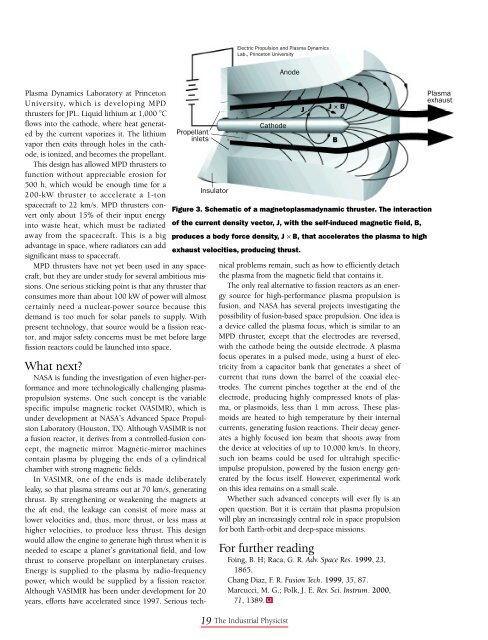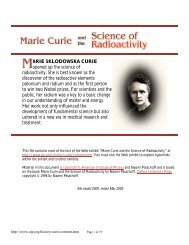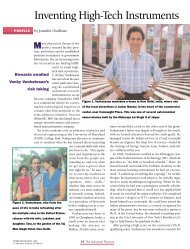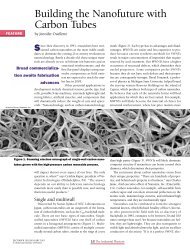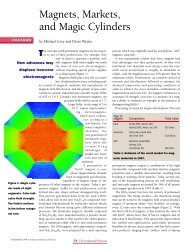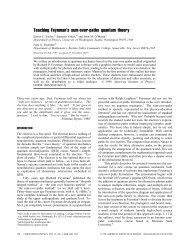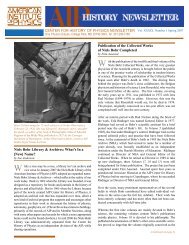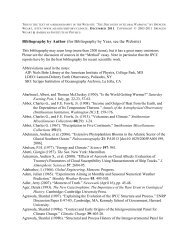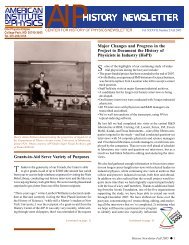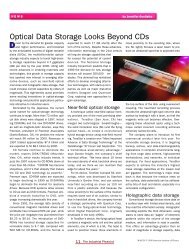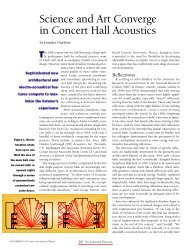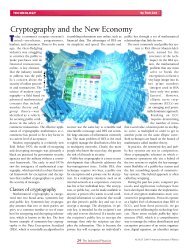Plasma Propulsion in Space - American Institute of Physics
Plasma Propulsion in Space - American Institute of Physics
Plasma Propulsion in Space - American Institute of Physics
Create successful ePaper yourself
Turn your PDF publications into a flip-book with our unique Google optimized e-Paper software.
<strong>Plasma</strong> Dynamics La b o r a t o ry at Pr<strong>in</strong>ceton<br />
U n i v e r s i t y, which is develop<strong>in</strong>g MPD<br />
thrusters for JPL. Liquid lithium at 1,000 °C<br />
flows <strong>in</strong>to the cathode, where heat generated<br />
by the current vaporizes it. The lithium Propellant<br />
<strong>in</strong>lets<br />
vapor then exits through holes <strong>in</strong> the cathode,<br />
is ionized, and becomes the propellant.<br />
This design has allowed MPD thrusters to<br />
function without appreciable erosion for<br />
500 h, which would be enough time for a<br />
200-kW thruster to accelerate a 1-ton<br />
spacecraft to 22 km/s. MPD thrusters convert<br />
only about 15% <strong>of</strong> their <strong>in</strong>put energy<br />
<strong>in</strong>to waste heat, which must be radiated<br />
away from the spacecraft. This is a big<br />
advantage <strong>in</strong> space, where radiators can add<br />
significant mass to spacecraft.<br />
MPD thrusters have not yet been used <strong>in</strong> any spacecraft,<br />
but they are under study for several ambitious missions.<br />
One serious stick<strong>in</strong>g po<strong>in</strong>t is that any thruster that<br />
consumes more than about 100 kW <strong>of</strong> power will almost<br />
certa<strong>in</strong>ly need a nuclear-power source because this<br />
demand is too much for solar panels to supply. With<br />
present technology, that source would be a fission reactor,<br />
and major safety concerns must be met before large<br />
fission reactors could be launched <strong>in</strong>to space.<br />
What next?<br />
NASA is fund<strong>in</strong>g the <strong>in</strong>vestigation <strong>of</strong> even higher-performance<br />
and more technologically challeng<strong>in</strong>g plasmapropulsion<br />
systems. One such concept is the variable<br />
specific impulse magnetic rocket (VASIMR), which is<br />
under development at NASA’s Advanced <strong>Space</strong> <strong>Propulsion</strong><br />
Laboratory (Houston, TX). Although VASIMR is not<br />
a fusion reactor, it derives from a controlled-fusion concept,<br />
the magnetic mirror. Magnetic-mirror mach<strong>in</strong>es<br />
conta<strong>in</strong> plasma by plugg<strong>in</strong>g the ends <strong>of</strong> a cyl<strong>in</strong>drical<br />
chamber with strong magnetic fields.<br />
In VA S I M R, one <strong>of</strong> the ends is made deliberately<br />
leaky, so that plasma streams out at 70 km/s, generat<strong>in</strong>g<br />
thrust. By strengthen<strong>in</strong>g or weaken<strong>in</strong>g the magnets at<br />
the aft end, the leakage can consist <strong>of</strong> more mass at<br />
lower velocities and, thus, more thrust, or less mass at<br />
higher velocities, to produce less thrust. This design<br />
would allow the eng<strong>in</strong>e to generate high thrust when it is<br />
needed to escape a planet’s gravitational field, and low<br />
thrust to conserve propellant on <strong>in</strong>terplanetary cruises.<br />
Energy is supplied to the plasma by radio- f r e q u e n c y<br />
p o w e r, which would be supplied by a fission reactor.<br />
Although VASIMIR has been under development for 20<br />
years, efforts have accelerated s<strong>in</strong>ce 1997. Serious tech-<br />
Insulator<br />
Electric <strong>Propulsion</strong> and <strong>Plasma</strong> Dynamics<br />
Lab., Pr<strong>in</strong>ceton University<br />
Cathode<br />
Anode<br />
Figure 3. Schematic <strong>of</strong> a magnetoplasmadynamic thruster. The <strong>in</strong>teraction<br />
<strong>of</strong> the current density vector, J, with the self-<strong>in</strong>duced magnetic field, B,<br />
produces a body force density, J × B, that accelerates the plasma to high<br />
exhaust velocities, produc<strong>in</strong>g thrust.<br />
nical problems rema<strong>in</strong>, such as how to efficiently detach<br />
the plasma from the magnetic field that conta<strong>in</strong>s it.<br />
The only real alternative to fission reactors as an energy<br />
source for high-performance plasma propulsion is<br />
fusion, and NASA has several projects <strong>in</strong>vestigat<strong>in</strong>g the<br />
possibility <strong>of</strong> fusion-based space propulsion. One idea is<br />
a device called the plasma focus, which is similar to an<br />
MPD thruster, except that the electrodes are reversed,<br />
with the cathode be<strong>in</strong>g the outside electrode. A plasma<br />
focus operates <strong>in</strong> a pulsed mode, us<strong>in</strong>g a burst <strong>of</strong> electricity<br />
from a capacitor bank that generates a sheet <strong>of</strong><br />
current that runs down the barrel <strong>of</strong> the coaxial electrodes.<br />
The current p<strong>in</strong>ches together at the end <strong>of</strong> the<br />
electrode, produc<strong>in</strong>g highly compressed knots <strong>of</strong> plasma,<br />
or plasmoids, less than 1 mm across. These plasmoids<br />
are heated to high temperature by their <strong>in</strong>ternal<br />
currents, generat<strong>in</strong>g fusion reactions. Their decay generates<br />
a highly focused ion beam that shoots away from<br />
the device at velocities <strong>of</strong> up to 10,000 km/s. In theory,<br />
such ion beams could be used for ultrahigh specificimpulse<br />
propulsion, powered by the fusion energy generated<br />
by the focus itself. However, experimental work<br />
on this idea rema<strong>in</strong>s on a small scale.<br />
Whether such advanced concepts will ever fly is an<br />
open question. But it is certa<strong>in</strong> that plasma propulsion<br />
will play an <strong>in</strong>creas<strong>in</strong>gly central role <strong>in</strong> space propulsion<br />
for both Earth-orbit and deep-space missions.<br />
For further read<strong>in</strong>g<br />
Fo<strong>in</strong>g, B. H; Raca, G. R. Adv. <strong>Space</strong> Res. 1999, 23,<br />
1865.<br />
Chang Diaz, F. R. Fusion Tech. 1999, 35, 87.<br />
Marcucci, M. G.; Polk, J. E. Rev. Sci. Instrum. 2000,<br />
71, 1389.<br />
19 The Industrial Physicist<br />
J<br />
J B<br />
B<br />
<strong>Plasma</strong><br />
exhaust


